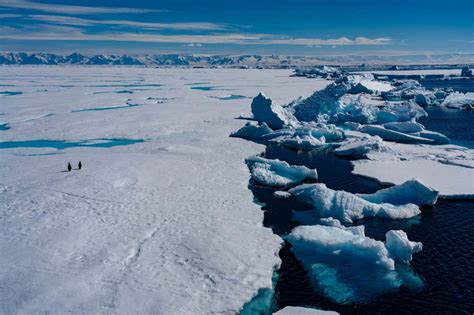
A puzzling surge in Antarctic sea ice has left scientists surprised, potentially signaling a dramatic shift in a region previously marked by accelerating ice loss. Recent data reveals an unexpected increase in ice extent, prompting researchers to investigate whether this marks a short-term anomaly or the beginning of a longer-term trend that could reshape our understanding of the Antarctic climate system.
Antarctic Sea Ice Defies Expectations with Unexpected Growth
After decades of consistent decline, Antarctic sea ice is exhibiting a surprising recovery, leaving scientists questioning established climate models and the future of the frozen continent. The unprecedented shift, observed in recent months, represents a significant departure from projections that anticipated continued ice loss due to global warming. While the Arctic has experienced a well-documented decline in sea ice, the Antarctic has presented a more complex and less predictable picture. The recent surge raises critical questions about the drivers of Antarctic sea ice variability and the accuracy of current climate models in capturing the region’s unique dynamics.
“After several years of record low Antarctic sea ice extent, in recent months the sea ice extent has rebounded, and it’s been quite substantial,” said Dr. Michael Meredith, Head of the Polar Oceans Team at the British Antarctic Survey. This unexpected growth challenges the narrative of consistent, climate change-driven decline and forces a reassessment of the factors influencing Antarctic sea ice.
The increase in sea ice is particularly noteworthy given the backdrop of overall global warming. Scientists emphasize that this single event does not negate the broader trend of climate change, but rather highlights the complex regional variations and feedback mechanisms that influence polar ice dynamics. Understanding the reasons behind this unexpected growth is crucial for refining climate models and predicting future changes in both the Antarctic and the global climate system.
The implications of this shift are far-reaching. Antarctic sea ice plays a vital role in regulating ocean temperatures, influencing ocean currents, and providing habitat for a diverse array of marine life, including penguins, seals, and krill. Changes in sea ice extent can have cascading effects throughout the Antarctic ecosystem and beyond, impacting global weather patterns and sea levels.
Researchers are employing a variety of tools, including satellite data, oceanographic observations, and climate models, to investigate the causes of the recent sea ice increase. Possible contributing factors include changes in wind patterns, ocean temperatures, and the amount of freshwater entering the ocean from melting glaciers and ice shelves. However, disentangling the complex interplay of these factors remains a significant challenge.
A Region of Contrasts: Understanding Antarctic Sea Ice Variability
Unlike the Arctic, where sea ice decline is largely driven by rising air temperatures, the Antarctic experiences a more complex interplay of factors that influence sea ice extent. While the Arctic is a landlocked ocean surrounded by continents, the Antarctic is a continent surrounded by a vast, open ocean. This difference in geography leads to distinct atmospheric and oceanic circulation patterns that influence sea ice formation and melt.
One key factor is the role of wind patterns. Strong winds circulating around the Antarctic continent can push sea ice further out to sea, increasing its overall extent. Changes in these wind patterns, driven by natural climate variability or human-induced climate change, can have a significant impact on sea ice distribution.
Ocean temperatures also play a crucial role. Warmer ocean waters can melt sea ice from below, while cooler waters can promote ice formation. The interaction between the ocean and the atmosphere is complex, with changes in one influencing the other. For example, increased melting of glaciers and ice shelves can release large amounts of freshwater into the ocean, which can alter ocean salinity and density, affecting sea ice formation.
Furthermore, the topography of the Antarctic continent itself influences sea ice distribution. Coastal polynyas, areas of open water surrounded by sea ice, are common features along the Antarctic coastline. These polynyas are formed by strong winds that push ice away from the coast, creating areas of open water that can then freeze, adding to the overall sea ice extent.
The interplay of these factors makes predicting Antarctic sea ice changes a significant challenge. Climate models must accurately represent these complex processes to provide reliable projections of future sea ice trends. The recent surge in sea ice highlights the need for continued research and improved model development to better understand the Antarctic climate system.
Possible Explanations for the Recent Surge
Several hypotheses are being explored to explain the recent increase in Antarctic sea ice. These include:
- Changes in Wind Patterns: Shifts in the strength and direction of winds around Antarctica can significantly alter sea ice distribution. Stronger winds can push ice further out to sea, increasing its extent, while weaker winds can allow ice to melt more readily.
- Ocean Temperature Variations: Changes in ocean temperatures can directly affect sea ice formation and melt. Cooler ocean waters can promote ice formation, while warmer waters can accelerate melting. These temperature variations can be influenced by factors such as changes in ocean currents and the influx of freshwater from melting glaciers and ice shelves.
- Freshwater Input: Increased melting of glaciers and ice shelves releases large amounts of freshwater into the ocean. This freshwater is less dense than saltwater, and it can form a layer on the surface of the ocean that inhibits vertical mixing. This stratification can lead to cooler surface temperatures, which can promote sea ice formation.
- Natural Climate Variability: The Antarctic climate system is subject to natural variations, such as the Antarctic Oscillation (AAO), which can influence wind patterns and ocean temperatures. These natural variations can cause short-term fluctuations in sea ice extent that may mask longer-term trends.
Dr. Ariaan Purich, a sea ice researcher from Monash University, noted the complexity of the system. “There are all sorts of different drivers and it’s really hard to pinpoint exactly what’s causing a change in Antarctic sea ice… there’s not one smoking gun.”
Researchers are using climate models to test these hypotheses and determine the relative importance of each factor. However, disentangling the complex interplay of these factors remains a significant challenge. It is likely that a combination of these factors is responsible for the recent surge in sea ice.
The Role of Climate Models and Future Projections
The recent surge in Antarctic sea ice has raised questions about the accuracy of current climate models in predicting changes in the region. While climate models are sophisticated tools that can simulate many aspects of the climate system, they are not perfect. They rely on simplifying assumptions and approximations, and they may not fully capture all of the complex processes that influence Antarctic sea ice.
One challenge is representing the interaction between the ocean, atmosphere, and sea ice in sufficient detail. Climate models must accurately simulate wind patterns, ocean currents, and the thermodynamic processes that govern ice formation and melt. This requires high-resolution models and accurate data on ocean temperatures, salinity, and ice thickness.
Another challenge is representing the impact of freshwater input from melting glaciers and ice shelves. The influx of freshwater can alter ocean salinity and density, affecting sea ice formation and ocean circulation. Climate models must accurately simulate these processes to project future sea ice trends.
The recent surge in sea ice highlights the need for continued improvement in climate models. Researchers are working to incorporate more detailed representations of these processes into their models and to improve the accuracy of model projections.
Despite the challenges, climate models remain a valuable tool for understanding the Antarctic climate system and projecting future changes. By comparing model simulations with observations, researchers can identify areas where models need improvement and refine their understanding of the processes that drive Antarctic sea ice variability.
Impact on Wildlife and Ecosystems
Changes in Antarctic sea ice have profound implications for the region’s wildlife and ecosystems. Sea ice provides critical habitat for a diverse array of marine life, including penguins, seals, krill, and fish. These animals rely on sea ice for breeding, feeding, and resting.
Penguins, for example, often breed on sea ice, and they depend on it as a platform for accessing feeding grounds. Changes in sea ice extent and timing can disrupt penguin breeding cycles and reduce their access to food.
Seals also rely on sea ice for breeding and resting. Some seal species, such as the Weddell seal, give birth on sea ice and depend on it as a safe haven from predators. Changes in sea ice can reduce the availability of suitable breeding habitat and increase the risk of predation.
Krill, small crustaceans that are a key food source for many Antarctic animals, also depend on sea ice. Sea ice provides habitat for algae, which krill feed on. Changes in sea ice can affect the abundance and distribution of krill, with cascading effects throughout the food web.
Changes in Antarctic sea ice can also impact ocean ecosystems. Sea ice influences ocean temperature, salinity, and nutrient distribution, which can affect the productivity of the ocean. Changes in sea ice can alter the balance of these factors, with potentially significant consequences for marine ecosystems.
The recent surge in sea ice may provide temporary relief for some of these species, but the long-term impacts of climate change on Antarctic ecosystems remain a major concern. Continued monitoring of sea ice and wildlife populations is essential to understanding the complex interactions between climate change, sea ice, and Antarctic ecosystems.
Global Implications and Sea Level Rise
While the Antarctic sea ice extent itself doesn’t directly contribute to sea-level rise (because it’s already floating), it plays a critical indirect role in the stability of the Antarctic ice shelves and the larger West Antarctic Ice Sheet, which, if melted, would contribute significantly to sea-level rise.
The sea ice acts as a buffer protecting these ice shelves from wave action and warmer ocean currents. When sea ice diminishes, the ice shelves are more vulnerable to melting from below and disintegration, which then allows the glaciers that feed into them to flow faster into the ocean. This acceleration is a major driver of sea-level rise.
Changes in Antarctic sea ice can also impact global weather patterns. Sea ice reflects sunlight back into space, helping to regulate the Earth’s temperature. Changes in sea ice extent can alter the amount of sunlight reflected, which can affect regional and global climate.
Furthermore, Antarctic sea ice plays a role in regulating ocean currents. The formation of sea ice releases salt into the surrounding water, making it denser and causing it to sink. This sinking water drives ocean currents, which transport heat and nutrients around the globe. Changes in sea ice formation can alter these ocean currents, with potentially significant consequences for global climate.
Therefore, understanding the dynamics of Antarctic sea ice is crucial for predicting future sea-level rise and understanding the impacts of climate change on global weather patterns. The recent surge in sea ice highlights the complexity of the Antarctic climate system and the need for continued research to improve our understanding of the region’s role in the global climate.
Future Research Directions
The recent surge in Antarctic sea ice underscores the need for continued research to understand the complex dynamics of the Antarctic climate system. Future research directions include:
- Improved Climate Models: Developing more sophisticated climate models that can accurately simulate the interaction between the ocean, atmosphere, and sea ice. This requires high-resolution models and accurate data on ocean temperatures, salinity, and ice thickness.
- Enhanced Monitoring: Expanding monitoring efforts in the Antarctic to collect more data on sea ice extent, thickness, and composition. This includes using satellite observations, automated buoys, and ship-based measurements.
- Process Studies: Conducting detailed process studies to understand the mechanisms that drive sea ice formation and melt. This includes studying the role of wind patterns, ocean currents, and freshwater input from melting glaciers and ice shelves.
- Ecosystem Research: Investigating the impacts of changes in sea ice on Antarctic wildlife and ecosystems. This includes monitoring penguin and seal populations, studying the distribution and abundance of krill, and assessing the health of marine ecosystems.
- Paleoclimate Studies: Studying past changes in Antarctic sea ice to understand the long-term variability of the region’s climate. This includes analyzing ice cores and sediment records to reconstruct past sea ice conditions.
By pursuing these research directions, scientists can improve our understanding of the Antarctic climate system and better predict future changes in sea ice. This knowledge is essential for informing policy decisions and mitigating the impacts of climate change on the Antarctic and the global climate.
International Collaboration
Understanding the Antarctic climate system requires international collaboration. Researchers from around the world are working together to collect data, develop models, and conduct research on Antarctic sea ice.
International organizations such as the Scientific Committee on Antarctic Research (SCAR) and the Antarctic Treaty System (ATS) play a key role in coordinating research efforts and promoting international cooperation. These organizations provide a framework for sharing data, developing research priorities, and addressing environmental challenges in the Antarctic.
The Antarctic Treaty System, in particular, promotes peaceful use of the continent for scientific research and prohibits military activities. This treaty has been instrumental in fostering international collaboration and protecting the Antarctic environment.
Continued international collaboration is essential for advancing our understanding of the Antarctic climate system and addressing the challenges posed by climate change. By working together, scientists can improve our knowledge of this critical region and help to protect its unique environment.
Conclusion: A Call for Continued Vigilance
The recent surge in Antarctic sea ice serves as a reminder that the Antarctic climate system is complex and dynamic. While the increase may be temporary, it highlights the need for continued monitoring and research to understand the factors that drive Antarctic sea ice variability.
The long-term trend in Antarctic sea ice remains uncertain, but climate models generally project a decline in sea ice extent in the coming decades. This decline could have significant implications for Antarctic wildlife, ecosystems, and global sea levels.
Therefore, it is crucial to continue to monitor Antarctic sea ice, improve climate models, and reduce greenhouse gas emissions. By taking these steps, we can protect the Antarctic environment and mitigate the impacts of climate change on the global climate system. The unexpected turn of events should serve not as a reason for complacency, but as a call for heightened vigilance and a renewed commitment to understanding and addressing the challenges of climate change in one of the most critical regions on Earth. The future of the Antarctic, and indeed the planet, may depend on it. Continued research and analysis are crucial to determine whether this is a temporary anomaly or the start of a new trend. The global scientific community remains focused on unraveling the mysteries of the Antarctic and its critical role in the Earth’s climate system.
Frequently Asked Questions (FAQ)
1. What is causing the unexpected increase in Antarctic sea ice?
Scientists are still investigating the exact causes, but potential factors include changes in wind patterns that push ice further out to sea, variations in ocean temperatures that promote ice formation, increased freshwater input from melting glaciers affecting ocean salinity, and natural climate variability like the Antarctic Oscillation (AAO). There’s likely no single “smoking gun,” but a combination of these factors is at play.
2. Does this increase in sea ice mean that climate change is not happening?
No. This single event doesn’t negate the broader trend of global warming. While the Arctic is experiencing consistent sea ice decline due to rising temperatures, the Antarctic is more complex. The increase highlights regional variations and feedback mechanisms influencing polar ice, emphasizing the need for nuanced understanding.
3. How does Antarctic sea ice affect sea levels?
Antarctic sea ice itself doesn’t directly contribute to sea-level rise because it’s already floating. However, it acts as a vital buffer protecting ice shelves (extensions of land-based glaciers) from wave action and warmer ocean currents. When sea ice diminishes, ice shelves become more vulnerable, potentially leading to the faster flow of glaciers into the ocean, which then contributes to sea-level rise.
4. What impact does this have on Antarctic wildlife?
Changes in sea ice affect wildlife like penguins, seals, and krill, which rely on it for breeding, feeding, and habitat. Penguins often breed on sea ice, and seals use it for resting and giving birth. Krill feed on algae that grow on sea ice. The recent increase may provide temporary relief for some species, but long-term impacts remain a concern.
5. What are scientists doing to further study this phenomenon?
Researchers are using various methods including:
- Improved Climate Models: Developing more sophisticated climate models.
- Enhanced Monitoring: Expanding monitoring efforts.
- Process Studies: Conducting detailed process studies.
- Ecosystem Research: Investigating the impacts on Antarctic wildlife.
- Paleoclimate Studies: Studying past changes in Antarctic sea ice. They also focus on enhanced collaboration to share data and conduct collaborative researches.









